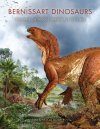![Bernissart Dinosaurs and Early Cretaceous Terrestrial Ecosystems Bernissart Dinosaurs and Early Cretaceous Terrestrial Ecosystems]()
Click to have a closer look
About this book
Contents
Customer reviews
Biography
Related titles
About this book
In 1878, the first complete dinosaur skeleton was discovered in a coal mine in Bernissart, Belgium. Iguanodon, first described by Gideon Mantell on the basis of fragments discovered in England in 1824, was initially reconstructed as an iguana-like reptile or a heavily built, horned quadruped. However, the Bernissart skeleton changed all that. The animal was displayed in an upright posture similar to a kangaroo, and later with its tail off the ground like the dinosaur we know of today.
Focusing on the Bernissant discoveries, Bernissart Dinosaurs and Early Cretaceous Terrestrial Ecosystems presents the latest research on Iguanodon and other denizens of the Cretaceous ecosystems of Europe, Asia, and Africa. Pascal Godefroit and contributors consider the Bernissart locality itself and the new research programs that are underway there. The systematic revision of Iguanodon; new material from Spain, Romania, China, and Kazakhstan; studies of other Early Cretaceous terrestrial ecosystems; and examinations of Cretaceous vertebrate faunas are also explored.
Contents
Contributors
Preface by David B. Norman
Acknowledgments
Section I. New Investigations into the Iguanodon Sinkhole at Bernissart and Other Early Cretaceous Localities in the Mons Basin (Belgium)
1. Bernissart and the Iguanodons: Historical Perspective and New Investigations
2. The Attempted Theft of Dinosaur Skeletons during the German Occupation of Belgium (1914-1918)
3. A Short Introduction to the Geology of the Mons Basin and the Bernissart Sinkhole
4. 3-D Modelling of the Paleozoic Top Surface in the Bernissart Area and Integration of Data from Boreholes Drilled in the Iguanodon Sinkhole
5. The Karstic Phenomenon of the Iguanodon Sinkhole and the Geomorphological Situation of the Mons Basin during the Early Cretaceous
6. Geodynamic and Tectonic context of Early Cretaceous Iguanodon-Bearing Deposits in the Mons Basin
7. Biostratigraphy of the Cretaceous Sediments Overlying the Wealden Facies in the Iguanodon Sinkhole at Bernissart
8. On the Age of the Bernissart Iguanodons
9. The Paleoenvironment of the Bernissart Iguanodons: Sedimentological Analysis of the Lower Cretaceous Wealden Facies in the Bernissart Area
10. Mesofossil Plant Remains from the Barremian of Hautrage (Mons Basin, Belgium), with Taphonomy, Palaeoecology, and Palaeoenvironment Insights
11. Diagenesis of the Fossil Bones of Iguanodon bernissartensis
12. Histological Assessment of Vertebrate Remains in the 2003 Bernissart Drill
13. Early Cretaceous Dinosaur Remains from Baudour (Belgium)
14. Geological Model and Cyclic Mass-Mortality Scenarios for the Lower Cretaceous Iguanodon Bonebeds of Bernissart
Section II. The Bernissart Iguanodons and Their Kin
15. Iguanodontian Taxa (Dinosauria: Ornithischia) from the Lower Cretaceous of England and Belgium
16. The Brain of Iguanodon and Mantellisaurus: Perspectives on Ornithopod Evolution
17. Hypsilophodon foxii and Other Smaller Bipedal Ornithischian Dinosaurs from the Lower Cretaceous of Southern England
18. The African Cousins of the European Iguanodontids
19. Anatomy and Relationships of Bolong yixianensis, an Early Cretaceous Iguanodontoid Dinosaur from Western Liaoning, China
20. A New Basal Hadrosauroid Dinosaur from the Late Cretaceous of Kazakhstan
Section III. Early Cretaceous Terrestrial Ecosystems In and Outside Europe
21. Dinosaur Remains from the "Sables Verts" (Early Cretaceous, Albian) of the Eastern Paris Basin
22. Dinosaur Faunas from the Early Cretaceous (Valanginian-Albian) of Spain
23. New Early Cretaceous Multituberculate Mammals from the Iberian Peninsula
24. Danish Dinosaurs: A Review
25. The Age of Lycoptera Beds (Jehol Biota) in Transbaikalia (Russia) and Correlation with Mongolia and China
26. A New Basal Ornithomimosaur (Dinosauria: Theropoda) from the Early Cretaceous Yixian Formation, Northwest China
27. Australia's Polar Early Cretaceous Dinosaurs
28. Assessment of the Potential for a Jehol Biota-like Cretaceous Polar Fossil Assemblage in Victoria, Australia
29. Freshwater Hybodont Sharks in Early Cretaceous Ecosystems: A Review
Section IV. Cretaceous Vertebrate Faunas after the Bernissart Iguanodons
30. The Late Cretaceous Continental Vertebrate Fauna from Ihark#t (Western Hungary): A Review
31. First Discovery of Maastrichtian (Latest Cretaceous) Terrestrial Vertebrates in Rusca Montana Basin (Romania)
32. First Maastrichtian (Latest Cretaceous) Vertebrate Assemblage from Provence (Vitrolles-la-Plaine, Southern France)
33. Reassessment of the Posterior Brain Region in Multituberculate Mammals
Index
Customer Reviews
Biography
Pascal Godefroit is Professor of Paleontology at the Royal Belgian Institute of Natural Sciences in Brussels.







































![Pravěký Svět Zdeňka Buriana, Kniha 2: Monstra Třetihor a Čtvrtohor [The Prehistoric World of Zdeněk Burian, Volume 2: Tertiary and Quaternary Monsters]](http://mediacdn.nhbs.com/jackets/jackets_resizer_medium/26/263198.jpg?height=150&width=108)








